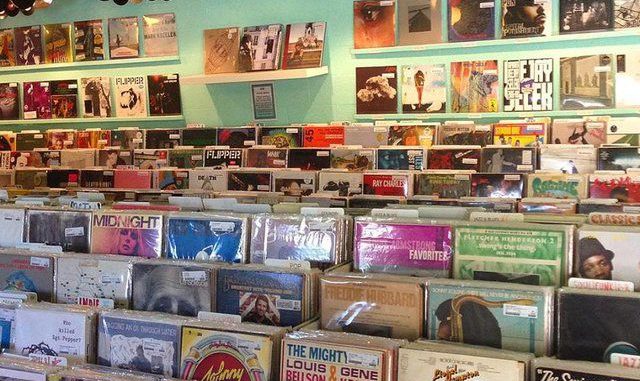
From rockerteeshirts.com
ALBUM SALES IN THE U.S. HAVE NOW TOPPED $3 BILLION

Who’s buying all the vinyl? It’s not just aging hippies nostalgic for the days when they rolled joints on the back of album covers. Somewhat surprisingly, the millennials, people who weren’t born until vinyl was considered passé, are leading the way. They aren’t buying them as an investment in their future. They aren’t betting that their record collections are going to be worth more in 30 years. They are buying them to play them on turntables, not to frame and hang on their walls.
It’s now cool to own vinyl and it looks better on your shelves than as a jpeg on a computer or smartphone screen. It’s comforting and tangible to have vinyl in the house, despite the endless stream of digital music—from Spotify, Apple, or Pandora or vendors of music new and old.
Music fans always enjoy a comeback story from the return to performing of a favorite band. (If the fans had had their way The Beatles would have reunited) and the renaissance of vinyl records is just as exciting. Consumers and collectors spend more money on vinyl records today than they have in years, and millennials are one of the reasons sales are so brisk.
In 2014, more than 13 million were sold in America alone. The RIAA (Recording Industry Association of America) hadn’t reported such high numbers since 1989 when CD sales took off and vinyl nearly became obsolete. Vinyl LP sales have continued to grow each year since. Industry researchers report that half of vinyl record buyers are now under 25—and this is without women having fully joined their ranks.
“It’s definitely a bright spot for the business,” RIAA’s Josh Friedlander, the association’s senior vice president of strategic data analysis, told CNBC. “In an increasingly digital age, vinyl records can provide a deeper, tactile connection to music that resonates with some of the biggest fans.”
The music industry itself has not prospered with the advent of streaming digital music. Artists no longer routinely sell tens of millions of albums and go multi-platinum. Touring, licensing songs for TV and radio commercials, and merchandising—everything from rock t-shirts and other rock apparel to a range of music memorabilia—make up for some of the losses now that album sales have fallen off but the resurgence of vinyl LP sales offers hope for regaining some of their lost revenue. Album sales in the U.S. have now topped $3 billion. 26% of American sales now come from vinyl, not CDs, downloading, or streaming.
Millions of consumers are again buying new LP records, legacy reissues, and collectibles. Gorillaz and Björk releases on vinyl and legacy recordings from bands like Led Zeppelin, Pink Floyd, or anything from Jack White’s Third Man Records are just a small part of the emerging trend.
Independent record stores barely exist anymore but even they are beginning to show up again. Stores that sell records, along with other products are selling LPs once more. In 2014, Urban Outfitters was reported to be the biggest vinyl retailer in the world. This may be uncertain, but online vendors like Amazon sell huge amounts of vinyl records. National retailers like Whole Foods, Walmart, and Best Buy are seeing vinyl sales become a plus. Vinyl record sales may bring in just a fraction of their overall revenue, but the rise in physical record sales gives them an opportunity to display them more visibly and drive more sales. Music executives are delighted with this turn of events, and perhaps musicians will be, too.
Are vinyl records a good investment? Well, you can’t invest in the remaining record plants. They are still small and are not yet good candidates for being publicly traded. If vinyl records continue to grow market share, we will eventually see this change.
If you buy vinyl records because you like the way they sound and the overall experience of collecting music in tangible form, you’re in luck. Eventually, your vinyl will become music memorabilia and take its place beside your vintage guitars, concert t-shirts, autographs, and photographs.
For collector Mauricio Cadena, recently featured on The Vinyl Factory’s website, there is no going back. He now has about 600 records he has acquired since 2011 and vinyl has become an important part of his life:
“It’s my sanctuary… my haven. Music has been part of my entire life. It’s my passion and everything I am and everything that I’ve been is somehow connected to music. And I think that my record collection is, ultimately, a tangible manifestation and reflection of myself, of my history.”
Vinyl is becoming part of our lifestyle again. As former half of The White Stripes and founder of Third Man Records, Jack White, said to Vice Magazine: “People are just tired of the invisibility of [today’s digital streaming scene], tired of the disposable nature of music for the last 10, 15 years. They gave away a turntable on The Price is Right last week. That shows you this is really happening.”
Explore eil.com… the world’s largest online retailer of rare and out of print vinyl, CDs and music memorabilia – since 1987.



My opinion about vinyl is back,This is great ,This is like magic or ritual,but new vinyl which is released before about,5,6 years,Sound on someone vinyl is digital sound on vinyl,and at the moment,I feel like Cd sound on New vinyl-remaster,because,Maybe original tape tracks is losted,I don,t know why?,but sound is not too much,different than old records,which is released,80 ih,70,ih and so on,this is pure anologue sound,depend label,I mean quality sound,but anyway sound is pure analogue,is not same like today new 180 gram vinyl which is released,and in the end,everyone know what is better sound,some people like pure anologue vinyl,some people new vinyl 180 gram,and some people also like buying mixed old anologue vinyl and new vinyl-180 gram